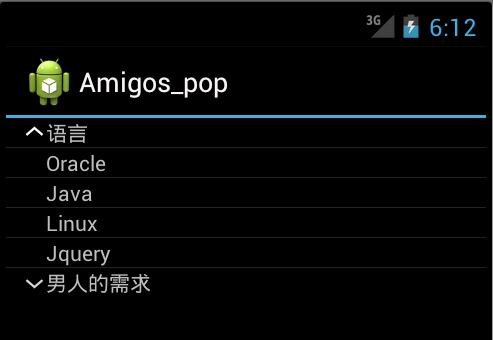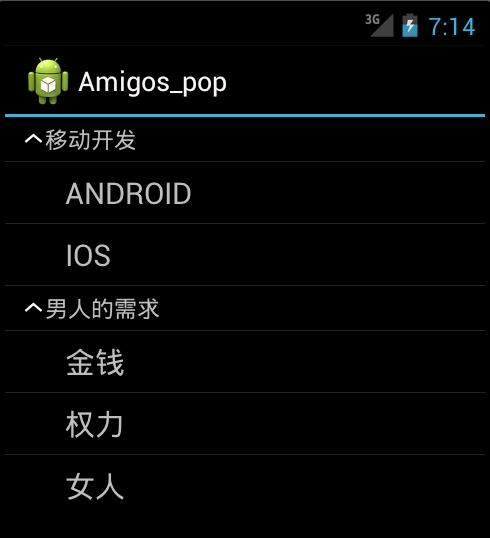android ExpandableListView详解
来源:互联网 发布:淘宝假ipad 编辑:程序博客网 时间:2024/04/28 13:36
转自http://my.oschina.net/amigos/blog/62614
ExpandableListView是android中可以实现下拉list的一个控件,是一个垂直滚动的心事两个级别列表项手风琴试图,列表项是来自ExpandableListViewaAdapter,组可以单独展开。
重要方法:
01expandGroup (intgroupPos) ;//在分组列表视图中 展开一组,02setSelectedGroup (intgroupPosition) ;//设置选择指定的组。03 04setSelectedChild (intgroupPosition, int childPosition, boolean shouldExpandGroup);//设置选择指定的子项。05 06getPackedPositionGroup (longpackedPosition);//返回所选择的组07 08getPackedPositionForChild (intgroupPosition, int childPosition) ;//返回所选择的子项09 10getPackedPositionType (longpackedPosition);//返回所选择项的类型(Child,Group)11 12isGroupExpanded (intgroupPosition);//判断此组是否展开expandableListView.setDivider();这个是设定每个Group之间的分割线。
expandableListView.setGroupIndicator();这个是设定每个Group之前的那个图标。
expandableListView.collapseGroup(int group); 将第group组收起
ExpandableListAdapter
一个接口,将基础数据链接到一个ExpandableListView。 此接口的实施将提供访问Child的数据(由组分类),并实例化的Child和Group。
1.重要方法
getChildId (int groupPosition, int childPosition) 获取与在给定组给予孩子相关的数据。
getChildrenCount (int groupPosition) 返回在指定Group的Child数目。
案例:
首先定义个一个布局文件expandablelistview.xml
01<?xmlversion="1.0"encoding="utf-8"?>02<LinearLayoutxmlns:android="http://schemas.android.com/apk/res/android"03 android:layout_width="fill_parent"04 android:layout_height="fill_parent"05 android:orientation="vertical">06 <ExpandableListView07 android:id="@+id/expandableListView" 08 android:layout_width="fill_parent" 09 android:layout_height="wrap_content" 10 >11 </ExpandableListView>12</LinearLayout>
001package com.test;002 003import java.util.ArrayList;004import java.util.List;005 006import javax.security.auth.PrivateCredentialPermission;007 008import android.app.Activity;009import android.os.Bundle;010import android.view.Gravity;011import android.view.View;012import android.view.ViewGroup;013import android.view.Window;014import android.widget.AbsListView;015import android.widget.BaseExpandableListAdapter;016import android.widget.ExpandableListView;017import android.widget.TextView;018 019public classExpandableListViewDemo extendsActivity {020 /** Called when the activity is first created. */021 022 //定义两个List用来控制Group和Child中的String;023 024 private List<String> groupArray;//组列表025 private List<List<String>> childArray;//子列表026 private ExpandableListView expandableListView_one;027 028 @Override029 publicvoid onCreate(Bundle savedInstanceState) {030 super.onCreate(savedInstanceState);031// requestWindowFeature(Window.FEATURE_NO_TITLE); //设置为无标题 032 setContentView(R.layout.expandablelistview);033 expandableListView_one =(ExpandableListView)findViewById(R.id.expandableListView);034 groupArray =newArrayList<String>();035 childArray =new ArrayList<List<String>>();036 037 /*-第一季-*/038 initdate();039 expandableListView_one.setAdapter(new ExpandableListViewaAdapter(ExpandableListViewDemo.this));040 041 /*-第二季-*/042// groupArray.add("移动开发");043// List<String> arrayList = new ArrayList<String>();044// arrayList.add("Android");045// arrayList.add("IOS");046// arrayList.add("Windows Phone");047// //组循环048// for(int index=0;index<groupArray.size();++index)049// {050// childArray.add(arrayList);051// }052// expandableListView_one.setAdapter(new ExpandableListViewaAdapter(ExpandableListViewDemo.this));053 054 }055 class ExpandableListViewaAdapter extends BaseExpandableListAdapter {056 Activity activity;057 public ExpandableListViewaAdapter(Activity a) 058 { 059 activity = a; 060 } 061 /*-----------------Child */062 @Override063 public Object getChild(int groupPosition, int childPosition) {064 // TODO Auto-generated method stub065 return childArray.get(groupPosition).get(childPosition);066 }067 068 @Override069 public long getChildId(int groupPosition, int childPosition) {070 // TODO Auto-generated method stub071 return childPosition;072 }073 074 @Override075 public View getChildView(int groupPosition, int childPosition,076 boolean isLastChild, View convertView, ViewGroup parent) {077 078 String string =childArray.get(groupPosition).get(childPosition);079 080 return getGenericView(string);081 }082 083 @Override084 public int getChildrenCount(int groupPosition) {085 // TODO Auto-generated method stub086 return childArray.get(groupPosition).size();087 }088 /* ----------------------------Group */089 @Override090 publicObject getGroup(int groupPosition) {091 // TODO Auto-generated method stub092 returngetGroup(groupPosition);093 }094 095 @Override096 publicint getGroupCount() {097 // TODO Auto-generated method stub098 returngroupArray.size();099 }100 101 @Override102 publiclong getGroupId(intgroupPosition) {103 // TODO Auto-generated method stub104 returngroupPosition;105 }106 107 @Override108 publicView getGroupView(int groupPosition, boolean isExpanded,109 View convertView, ViewGroup parent) {110 111 String string=groupArray.get(groupPosition);112 returngetGenericView(string);113 }114 115 @Override116 publicboolean hasStableIds() {117 // TODO Auto-generated method stub118 returnfalse;119 }120 121 @Override122 publicboolean isChildSelectable(intgroupPosition, int childPosition) 123 {124 // TODO Auto-generated method stub125 returntrue;126 }127 128 privateTextView getGenericView(String string ) 129 {130 AbsListView.LayoutParams layoutParams =newAbsListView.LayoutParams(131 ViewGroup.LayoutParams.MATCH_PARENT,132 ViewGroup.LayoutParams.WRAP_CONTENT);133 134 TextView textView =newTextView(activity);135 textView.setLayoutParams(layoutParams);136 137 textView.setGravity(Gravity.CENTER_VERTICAL |Gravity.LEFT);138 139 textView.setPadding(40,0, 0,0);140 textView.setText(string);141 returntextView;142 }143 }144 145 privatevoid initdate() 146 {147 addInfo("语言",new String[]{"Oracle","Java","Linux","Jquery"});148 addInfo("男人的需求",new String[]{"金钱","事业","权力","女人","房子","车","球"});149 }150 privatevoid addInfo(String group,String []child) {151 152 groupArray.add(group);153 154 List<String> childItem =newArrayList<String>();155 156 for(intindex=0;index<child.length;index++)157 {158 childItem.add(child[index]);159 }160 childArray.add(childItem);161 }162}运行效果:

注释修改如下代码:
01/*-第一季-*/02// initdate();03// expandableListView_one.setAdapter(new ExpandableListViewaAdapter(ExpandableListViewDemo.this));04 05 /*-第二季-*/06 groupArray.add("移动开发");07 List<String> arrayList =new ArrayList<String>();08 arrayList.add("Android");09 arrayList.add("IOS");10 arrayList.add("Windows Phone");11 //组循环12 for(intindex=0;index<groupArray.size();++index)13 {14 childArray.add(arrayList);15 }16 expandableListView_one.setAdapter(newExpandableListViewaAdapter(ExpandableListViewDemo.this));运行效果:

★★★★★★★★★★★★★★★★★★★★
案例二:
1.定义一个主界面expandablelistview.xml
01<?xml version="1.0"encoding="utf-8"?>02<LinearLayout xmlns:android="http://schemas.android.com/apk/res/android"03 android:layout_width="fill_parent"04 android:layout_height="fill_parent"05 android:orientation="vertical">06 <ExpandableListView07 android:id ="@+id/expandableListView" 08 android:layout_width ="fill_parent" 09 android:layout_height ="wrap_content" 10 >11 </ExpandableListView>12</LinearLayout>2.在res/drawable目录下创建样式文件expandablelistview_groups.xml该界面是组界面:
01<?xmlversion="1.0"encoding="utf-8"?>02<LinearLayoutxmlns:android="http://schemas.android.com/apk/res/android"03 android:layout_width="fill_parent"04 android:layout_height="fill_parent"05 android:orientation="vertical">06 <TextView07 android:id="@+id/textGroup" 08 android:layout_width="fill_parent" 09 android:layout_height="fill_parent" 10 android:paddingLeft="40px" 11 android:paddingTop="6px" 12 android:paddingBottom="6px" 13 android:textSize="15sp" 14 android:text="No data" 15 > 16 </TextView>17</LinearLayout>3.在res/drawable目录下创建样式文件expandablelistview_child.xml;是子控件,直接显示列表内容
01<?xmlversion="1.0"encoding="utf-8"?>02<LinearLayoutxmlns:android="http://schemas.android.com/apk/res/android"03 android:layout_width="fill_parent"04 android:layout_height="fill_parent"05 android:orientation="vertical">06 <TextView 07 android:id="@+id/textChild" 08 android:layout_width="fill_parent" 09 android:layout_height="fill_parent" 10 android:paddingLeft="60px" 11 android:paddingTop="10px" 12 android:paddingBottom="10px" 13 android:textSize="20sp" 14 android:text="No Data"/> 15</LinearLayout>定义java文件:ExpandableListViewDemo_two.java
001package com.test;002 003import java.util.ArrayList;004import java.util.HashMap;005import java.util.List;006import java.util.Map;007 008import javax.security.auth.PrivateCredentialPermission;009 010import com.test.R;011import com.test.ExpandableListViewDemo.ExpandableListViewaAdapter;012import com.test.R.id;013import com.test.R.layout;014 015import android.app.Activity;016import android.os.Bundle;017import android.view.Gravity;018import android.view.View;019import android.view.ViewGroup;020import android.view.Window;021import android.widget.AbsListView;022import android.widget.BaseExpandableListAdapter;023import android.widget.ExpandableListView;024import android.widget.SimpleExpandableListAdapter;025import android.widget.TextView;026 027public classExpandableListViewDemo_two extendsActivity {028 /** Called when the activity is first created. */ 029 private ExpandableListView expandableListView_one;030 @Override 031 publicvoid onCreate(Bundle savedInstanceState) 032 { 033 super.onCreate(savedInstanceState); 034 setContentView(R.layout.expandablelistview); 035 expandableListView_one =(ExpandableListView)findViewById(R.id.expandableListView); 036 //创建二个一级条目标题 037 Map<String, String> title_1 =new HashMap<String, String>(); 038 Map<String, String> title_2 =new HashMap<String, String>(); 039 040 title_1.put("group","移动开发"); 041 title_2.put("group","男人的需求"); 042 043 //创建一级条目容器 044 List<Map<String, String>> gruops =new ArrayList<Map<String,String>>(); 045 046 gruops.add(title_1); 047 gruops.add(title_2); 048 049 //创建二级条目内容 050 051 //内容一 052 Map<String, String> content_1 =new HashMap<String, String>(); 053 Map<String, String> content_2 =new HashMap<String, String>(); 054 055 content_1.put("child","ANDROID"); 056 content_2.put("child","IOS"); 057 058 List<Map<String, String>> childs_1 =new ArrayList<Map<String,String>>(); 059 childs_1.add(content_1); 060 childs_1.add(content_2); 061 062 //内容二 063 Map<String, String> content_3 =new HashMap<String, String>(); 064 Map<String, String> content_4 =new HashMap<String, String>(); 065 Map<String, String> content_5 =new HashMap<String, String>();066 067 content_3.put("child","金钱"); 068 content_4.put("child","权力"); 069 content_5.put("child","女人"); 070 List<Map<String, String>> childs_2 =new ArrayList<Map<String,String>>(); 071 childs_2.add(content_3); 072 childs_2.add(content_4); 073 childs_2.add(content_5);074 075 //存放两个内容, 以便显示在列表中 076 List<List<Map<String, String>>> childs =new ArrayList<List<Map<String,String>>>(); 077 childs.add(childs_1); 078 childs.add(childs_2); 079 080 //创建ExpandableList的Adapter容器 081/** 082* 使用SimpleExpandableListAdapter显示ExpandableListView 083* 参数1.上下文对象Context 084* 参数2.一级条目目录集合 085* 参数3.一级条目对应的布局文件 (expandablelistview_groups.xml文件086* 参数4.fromto,就是map中的key,指定要显示的对象 087* 参数5.与参数4对应,指定要显示在groups中的id 088* 参数6.二级条目目录集合 089* 参数7.二级条目对应的布局文件 090* 参数9.与参数8对应,指定要显示在childs中的id 091/ SimpleExpandableListAdapter adapter =new SimpleExpandableListAdapter( 092 this, gruops, R.drawable.expandablelistview_groups,new String[]{"group"},new int[]{R.id.textGroup}, 093 childs, R.drawable.expandablelistview_child,new String[]{"child"},new int[]{R.id.textChild} 094 ); 095 096 //加入列表 097 expandableListView_one.setAdapter(adapter);098 expandableListView_one.setOnChildClickListener(listener);099 } 100 privateOnChildClickListener listener =newOnChildClickListener() {101 @Override102 publicboolean onChildClick(ExpandableListView parent, View v,103 intgroupPosition, int childPosition, long id) {104 // TODO Auto-generated method stub105 toast("点击了");106 returnfalse;107 }108 };109 privatevoid toast(String str) {110 Toast.makeText(this, str, Toast.LENGTH_LONG).show(); 111 } 112}上面的样式也可以使用系统的自带的样式如下:
android.R.layout.simple_expandable_list_item_1,//层显示样式 ,系统自定义
android.R.layout.simple_expandable_list_item_2,
运行效果:

案例三:如果group中有个ImageVIew将会是什么情况呢?
在SimpleExpandableListAdapter中有如下方法:
01private voidbindView(View view, Map<String, ?> data, String[] from, int[] to) {02 intlen = to.length;03 04 for(int i = 0; i < len; i++) {05 TextView v = (TextView)view.findViewById(to[i]);06 if(v != null) {07 v.setText((String)data.get(from[i]));08 }09 }10 }从上面的方法中可以看出 SimpleExpandableListAdapter把所以的View都当成TextView来处理了,而不像SimpleAdapter可以自动判断View的类型,自动绑定,解决版本就是重写bingview回调一下试试:
01public classMyExpandableListAdapter extendsBaseExpandableListAdapter{02 privatevoid bindView(View view, Map<String, ?> data, String[] from,int[] to) {03 intlen = to.length;04 booleanisBound = false;05 for(int i = 0; i < len; i++) {06 finalView v = view.findViewById(to[i]);07 if(v!=null) {08 finalObject _data = data.get(from[i]);09 String text = _data ==null ? "": data.toString();10 if(text == null) {11 text ="";12 }13 if(mViewBinder != null) {//如果Binder不为空,使用Binder进行处理14 isBound = mViewBinder.setViewValue(v, data.get(from[i]), text);15 }16 if(!isBound) {//如果Binder跳过,使用原来的方法进行处理17 TextView _v = (TextView)v;18 _v.setText((String)data.get(from[i]));19 } 20 }21 }22 }23}- android ExpandableListView详解
- android ExpandableListView详解
- android ExpandableListView详解
- android ExpandableListView详解
- Android ExpandableListView详解
- 【Android基础】ExpandableListView详解
- android ExpandableListView详解
- android ExpandableListView详解
- android ExpandableListView详解
- android ExpandableListView详解
- 【Android UI设计】ExpandableListView详解
- 【Android UI设计】ExpandableListView详解
- Android中ExpandableListView的使用详解
- ExpandableListView详解
- ExpandableListView详解
- expandablelistview详解
- ExpandableListView详解
- expandablelistview详解
- 裸奔程序之定时器&PWM
- 主题:java并发编程-Executor框架
- Solr(3.3)添加中文分词——以IK为例
- 实例总结——错误
- VS 打印调试
- android ExpandableListView详解
- TextMate 2开源, 不要轻易重写应用
- HDU3172 Virtual Friends 并查集
- jQuery-滚动效果
- Android中ExpandableListView的使用
- 编程之美1.9
- 3Sum
- 制订计划时的参考
- Android 之ExpandableListView几个特殊的属性


